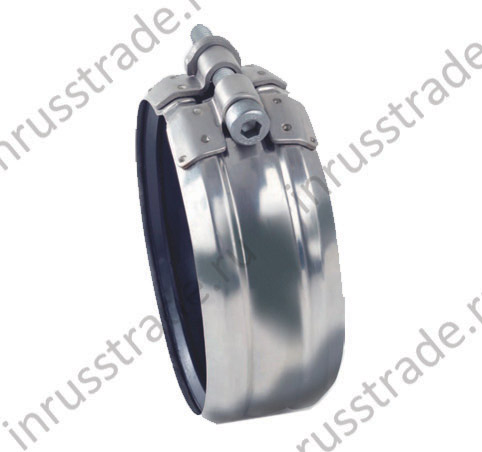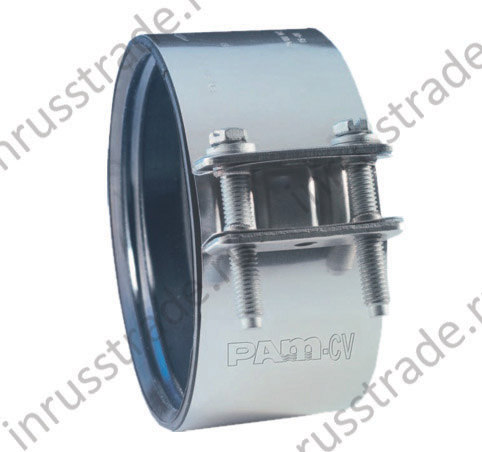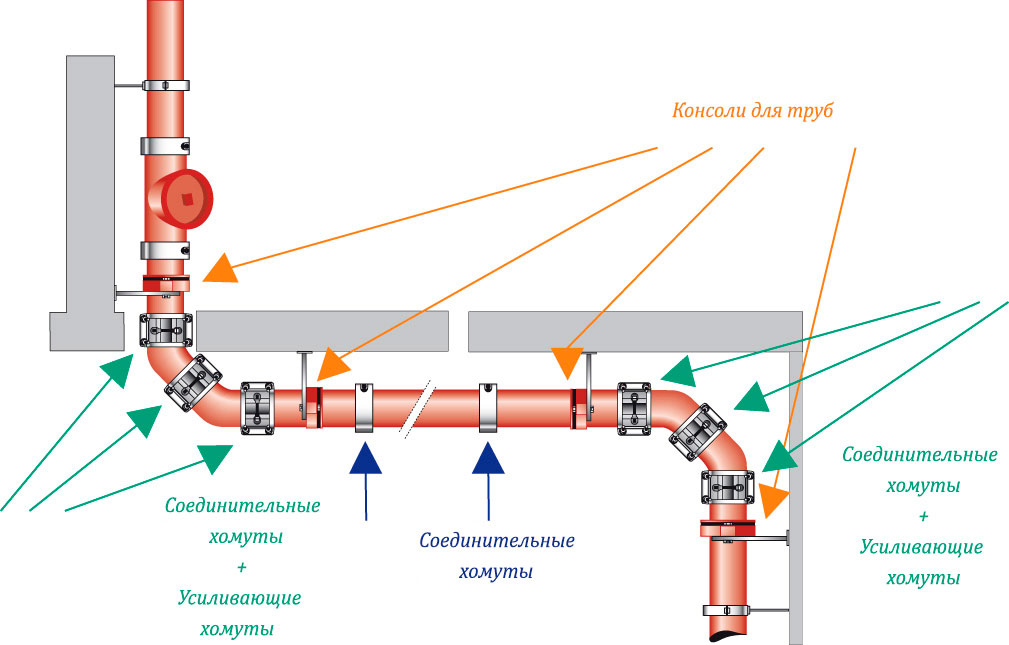
 |
 |
| Соединительный элемент PAM-GLOBAL® RAPID-S-W2 |
Соединительный элемент PAM-GLOBAL® CV |
При работе в агрессивных средах возможна поставка соединительных элементов PAM-GLOBAL® CЕ и PAM-GLOBAL® RAPID-INOX
Хотя канализационные и вентиляционные трубопроводы проектируются в принципе как безнапорные трубопроводы, это ни в коем случае не исключает того, что при определенных режимах работы в трубопроводах может возникать давление.
Поэтому канализационные трубопроводы должны выдерживать длительное внутренне и внешнее избыточное давление от 0 до 0,5 бар (5 м водного столба). Прокладки из всех допущенных материалов должны быть увеличены до этих давлений, поскольку элементы трубопроводов складируются или крепятся с продольным усилием. При возникновении продольных усилий необходимо применять усиливающие хомуты.
В связи с этим в требованиях к соединительным элементам для канализационных трубопроводов DIN 1986 (раздел часть 1, пункт 4, 6.1.10) указывается на надежное крепление трубопроводов. Это указание делается потому, что в основных положениях по строительству и испытаниям не выдвигаются требования к фиксации продольного усилия соединительных элементов.
Требование более надежного крепления или соединения с фиксацией продольного усилия действительно естественно в особой мере для канализационных трубопроводов, которые могут испытывать большее внутреннее давление, чем 0,5 бар, например:
E-DIN 1986-100 указывает на то, что для трубопроводов, которые могут подвергаться повышенному или пониженному давлению большему, чем 0,5 бар, например, дождевые коллекторы внутри зданий, должны предъявляться особые требования к трубам, фасонным частям, подвескам и опорам.
В разделе 6.1.12 указывается на соединение с фиксацией продольного усилия при планомерном внутреннем давлении, или возникающем при особых режимах эксплуатации.
Как раз в трубопроводах, находящихся в зоне подпора, может возникать рабочее давление, например, в результате подпора из канализационной сети, способные привести к выскальзыванию трубных соединений. По этой причине в отношении трубопроводов PAM-GLOBAL®, находящихся в зоне подпора, необходимо действовать следующим образом:
До 0,5 бар в зоне подпора
- Для соединительных элементов PAM-GLOBAL® RAPID диаметром до DN 100 не требуется никаких дополнительных мер.
- Для соединительных элементов PAM-GLOBAL® RAPID диаметром от DN 125 до DN 200 требуется фиксация при помощи усиливающих хомутов Rekord Kralle при изменении направления трубопровода.
- Для соединительных элементов PAM CV-/CE до 0,5 бар требуется фиксация при помощи усиливающих хомутов Rekord Kralle при изменении направления трубопровода.
Выше 0,5 бар в зоне подпора
- Все соединения PAM-GLOBAL® необходимо фиксировать при помощи усиливающих хомутов PAM-GLOBAL®.

В зависимости от конфигурации трубопровода, осевая нагрузка, оказываемая на трубы, может оказать влияние как на направление трубопровода, так и на его отдельные элементы, например, на отводы и заглушки. За нагрузками в этих местах следует особенно внимательно следить, чтобы снизить риск разрыва в трубопроводе:
Также могут исопльзоваться и другие методы снижения осевой нагрузки, например, анкерные опоры, закреплённые в бетоне, или упорная подушка.
Примечание: в случаях исопльзования одновременно соединительных хомутов и усиливающих хомутов их приозводительность ограничивается произвоидтельностью наиболее слабого продукта.
Осевая нагрузки при давлении 1 м водяного столба (кгс)
| DN | 50 | 75 | 100 | 125 | 150 | 200 | 250 | 300 | 400 | 500 | 600 |
|---|---|---|---|---|---|---|---|---|---|---|---|
 |
2 | 5 | 9 | 13 | 19 | 32 | 55 | 79 | 136 | 210 | 301 |
 |
3 | 6 | 12 | 19 | 26 | 46 | 78 | 111 | 192 | 297 | 426 |
 |
2 | 5 | 9 | 13 | 19 | 32 | 55 | 79 | 136 | 210 | 301 |